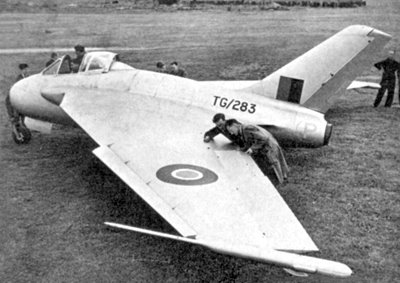The term ‘Mach number’ is named after the Austrian physicist, Ernst Mach (1838-1916). When an aircraft flies supersonically it produces a shock wave in the air, which may be heard on the ground as a ‘Sonic Bang’. The speed of sound is measured at 760 mph at sea level and 660 mph at 40,000 feet (Mach 1).
The business of who was first to fly supersonic is complicated; some aircraft first reached Mach 1 in level flight, whilst others reached it beforehand in a dive. US Captain Charles Yeager was the first in level flight, on 14th October 1947 in the Bell X-1. Next came American George Welch on 25th/26th April 1948 in the XP-86, prototype Sabre and followed by Briton Roland Beamont in the same aircraft on 21st May 1948.
The first Briton attributed to have reached Mach 1 in a British aircraft was John Derry on 6th September 1948 in the de Havilland DH 108 Swallow (third prototype VW/120), in a shallow dive from 40,000 to 30,000 feet.
The first prototype TG/283 was lost in a crash at Hartley Wintney on 1st May 1950 during low-speed sideslip and stall tests; pilot Sqn Ldr George E C Genders AFC DFM was killed when his parachute failed to open in time. The second prototype TG/306 suffered catastrophic structural failure in a dive from 10,000 feet at Mach 0.9 and crashed in the Thames Estuary killing pilot Geoffrey de Havilland Jr. The third prototype VW/120 was destroyed in a crash in Buckinghamshire on 15th February 1950, killing test pilot Sqn Ldr Stuart Muller-Rowland.
John Douglas Derry DFC (1921 – 1952) was killed at Farnborough Airshow when his DH 110 broke up and caused 29 fatalities including himself and flight observer Tony Richards.







No Comments
Add a comment about this page